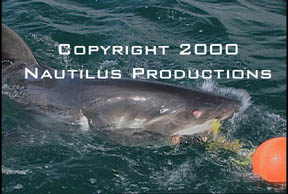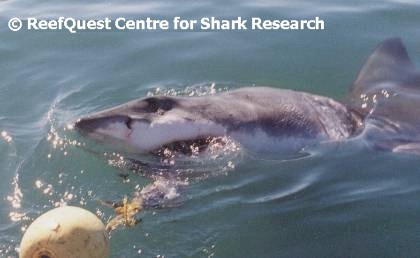White Shark Bite Kinematics —
Preliminary Exploration of a
New Aspect
 Of
all the things White Sharks do, none has received as much scientific and
popular attention as what happens when they bite. Until recently, much
of what we knew about White Shark biting behavior came from the dissection
and manipulation of the jaws of dead specimens. During the mid-1980's,
two scientific papers were published about the jaw and head movements that
occur during a White Shark biting sequence as revealed by the analysis of
high-speed film footage. But there is an odd aspect of the White Shark
biting sequence that — in all this oral fixation — has not previously been
described or studied and on which I provide a preliminary report here.
Of
all the things White Sharks do, none has received as much scientific and
popular attention as what happens when they bite. Until recently, much
of what we knew about White Shark biting behavior came from the dissection
and manipulation of the jaws of dead specimens. During the mid-1980's,
two scientific papers were published about the jaw and head movements that
occur during a White Shark biting sequence as revealed by the analysis of
high-speed film footage. But there is an odd aspect of the White Shark
biting sequence that — in all this oral fixation — has not previously been
described or studied and on which I provide a preliminary report here.
Like those of other sharks, the jaws of White Sharks are loosely slung below the chondrocranium (skull), enabling them to be protruded and thereby granting these predators extra reach as well as generating a partial pharyngeal (throat) vacuum to help 'suck' food into the mouth. The cartilaginous jaws of the White Shark are supported by a complex of cartilaginous arches and muscles that attach to the skull and other skeletal elements in complex ways. Those skeletal and muscular features germane to this discussion are represented diagrammatically below:
|
|
(Click for full- sized image) |
[Jump down to description of bite kinematics]

My colleague, Ralph Collier of the Shark Research Committee, has been studying White Sharks for more than 40 years. One day, while I was visiting him in California, Ralph mentioned to me that White Sharks sometimes have a curious 'hump' above the eye. I had often noticed this myself in film footage and published photos and assumed this eye hump was largely a matter of the particular angle at which a White Shark was viewed. Through raw (unedited) footage and unpublished stills in his collection, Ralph showed me compelling evidence that sometimes the 'hump' is there and sometimes it is not, the White Shark's head taking on the familiar, sleek bullet-like shape we all know and love.
 I
asked Ralph what he thought was going on with this strange 'disappearing'
eye hump. He told me that it's most obvious when a White Shark is
biting — or just about to bite — a food item, and therefore he thought it
might be a mechanism by which the shark protects its vulnerable eyes against
being hit or gouged during a prey animal's desperate, last-ditch escape
attempt. I have a great deal of
respect for Ralph's ideas about how and why White Sharks do what they do.
But, on this count, I felt strongly that he was wrong, spinning a sort of Darwinian
"Just So" story.
I
asked Ralph what he thought was going on with this strange 'disappearing'
eye hump. He told me that it's most obvious when a White Shark is
biting — or just about to bite — a food item, and therefore he thought it
might be a mechanism by which the shark protects its vulnerable eyes against
being hit or gouged during a prey animal's desperate, last-ditch escape
attempt. I have a great deal of
respect for Ralph's ideas about how and why White Sharks do what they do.
But, on this count, I felt strongly that he was wrong, spinning a sort of Darwinian
"Just So" story.
At the time, I had examined a few dead White Sharks and even been in the water with them on several occasions (once without benefit of a shark cage, but that's another story). But, like most people, I couldn't help focusing on the jaws, teeth, and stomach contents. I didn't know about the eye hump phenomenon and so didn't look for it in living animals. For over a decade, I never got a chance to observe a free-swimming White Shark — let alone had opportunity and enough time to study the context and mode of the appearance and disappearance of the eye hump in numerous live White Sharks, representing a large spectrum of growth stages. During my recent White Shark Expedition 2000, I finally got the chance to do just that.
 Based
on my observations of White Sharks in South Africa, it
now seems clear to me that the eye hump appears when the palatoquadrate (upper
jaw) is protruded and disappears when the jaws are retracted into the
head. Further, the degree of eye hump development is strongly correlated
with the degree of palatoquadrate protrusion. Therefore, rather than being
some kind of built-in ocular safety mechanism, I suspect that the curious
phenomenon of the appearing-disappearing eye hump is merely an artifact of
palatoquadrate protrusion.
Based
on my observations of White Sharks in South Africa, it
now seems clear to me that the eye hump appears when the palatoquadrate (upper
jaw) is protruded and disappears when the jaws are retracted into the
head. Further, the degree of eye hump development is strongly correlated
with the degree of palatoquadrate protrusion. Therefore, rather than being
some kind of built-in ocular safety mechanism, I suspect that the curious
phenomenon of the appearing-disappearing eye hump is merely an artifact of
palatoquadrate protrusion.
Here's what I think is going on. When a White Shark bites, its palatoquadrate is pulled forward and thrust downward by two muscle groups, the preorbitalis and levator palatoquadratii. As this happens, levator hyoideus muscles swing the hyoid arches forward from their 'relaxed' position — folded back alongside the head — into a 'rotated' position to brace the out-thrust jaws from behind. As in other vertebrates, the superficial (shallow) and deep muscles of the White Shark's head interconnect in complex ways. Because the superficial muscles attach directly to the shark's tough, armor-like skin, it is pulled forward and downward in the region behind the eye, thereby 'stretching' the skin over the post orbital process behind the eye on either side of the chondrocranium. [Pop up to the diagram]
This sequence of events creates the eye hump associated with palatoquadrate protrusion and explains why the 'intensity' of hump development is correlated with degree of palatoquadrate protrusion. When this process is reversed, the jaws retracting back into the head, thereby releasing skin tension over and behind the eyes and thus the eye hump 'disappears'.
The salient features of this process are shown diagramatically below.


My hypothesis can be tested using traditional methods of a scientific discipline called "functional morphology". Specifically, the muscles associated with palatoquadrate protrusion and retraction can be electrically stimulated in a fresh White Shark specimens. Most extant sharks possess, to a greater or lesser extent, protrusible jaws and chondrocrania with post orbital processes. It would therefore be interesting to study whether or not a comparable eye-hump occurs in such species as the Sandtiger (Carcharias taurus) or Goblin Shark (Mitsukurina owstoni), both of which have highly protrusible jaws.
If anything, all this makes biting behavior of the White Shark even more fascinating. And it provides a subtle but important object lesson (if you'll permit me): if one focuses too much on what a White Shark's jaws are doing, it's easy to miss all kinds of intriguing things.
